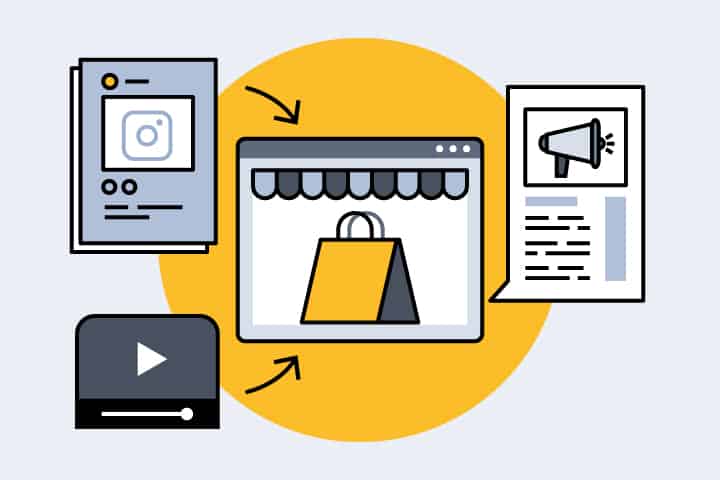Have you ever recommended a product to a friend and then thought, “Wouldn’t it be great if I got paid for this endorsement?” Well, that’s the essence of affiliate marketing! Imagine this: you’re browsing a blog about the latest tech gadgets. You click on a link for a new smartphone, and it takes you to an online store. If you buy that phone, the blogger gets a commission. That’s affiliate marketing in a nutshell.
But why is it important? For starters, affiliate marketing is incredibly cost-effective. Businesses only pay when a sale is made, which means they’re not throwing money at ads with uncertain returns. According to a study by the Performance Marketing Association, affiliate marketing accounted for 16% of e-commerce sales in the U.S. and Canada. That’s a significant chunk, highlighting its role in driving online sales.
How Affiliate Marketing Drives E-commerce Success
Affiliate marketing is not just a business tactic; it’s a growth engine for e-commerce. By leveraging affiliates—bloggers, influencers, and other content creators—businesses can tap into new audiences. These affiliates have established trust with their followers, making their recommendations much more effective than traditional ads.
Here’s an example: let’s say you run a boutique online store for eco-friendly products. By partnering with influencers in the sustainability space, you can reach eco-conscious buyers who trust these influencers’ recommendations. This approach not only broadens your reach but also aligns your brand with trusted voices in your niche.
Moreover, affiliate marketing is trackable and measurable. Through various tools, businesses can see which affiliates bring in the most traffic and sales. They can then optimize their strategies accordingly. For instance, a report by Rakuten Marketing reveals that advertisers earned an average of $12.3 for every dollar spent on affiliate marketing. This ROI is a testament to the effectiveness of this marketing approach.
To break it down further:
- Cost-Effectiveness: Pay for performance, not just exposure.
- Trust and Credibility: Leverage the trust influencers have with their audience.
- Measurable Results: Track the direct impact of your marketing efforts.
In conclusion, affiliate marketing is a powerful tool that leverages relationships and trust to drive sales. It’s a win-win for both merchants and affiliates, offering a smart way to expand reach, increase sales, and maximize ROI. And for businesses looking to thrive in the e-commerce arena, understanding and harnessing the power of affiliate marketing is not just an option—it’s a necessity.
As we delve deeper into the world of WooCommerce and affiliate marketing, let’s explore how these concepts intertwine and transform the way businesses grow online. Stay tuned!
Why Do You Need an Affiliate Marketing Program for Your WooCommerce Store?
Have you ever wondered how some online stores seem to have a magical touch, attracting customers and sales effortlessly? The secret might be a robust affiliate marketing program. In the dynamic world of e-commerce, standing out is not just about having great products; it’s about smart marketing. And here’s where affiliate marketing comes into play, especially for WooCommerce stores.
Imagine this scenario: You’re selling unique, handcrafted jewelry. By partnering with fashion bloggers and influencers, you’re not just placing your products in front of their audience; you’re essentially getting endorsed by them. According to a survey by Forrester, affiliate marketing accounts for 16% of all online orders. That’s a significant figure, indicating the power of affiliates in driving online sales.
Expanding Market Reach and Brand Visibility Through Affiliates
But it’s not just about boosting sales; it’s also about brand visibility and reach. Every time an affiliate shares your product, your store gains exposure to a new audience. This exposure is invaluable, especially considering the trust these audiences have in their chosen influencers or content creators.
Here’s a real-world example: Think of a WooCommerce store specializing in fitness gear. By partnering with fitness influencers and bloggers, the store taps into a dedicated community of fitness enthusiasts. This partnership isn’t just a transaction; it’s a strategic move to align the brand with key figures in the fitness community, boosting credibility and reach.
- Community Engagement: Affiliates bring your products into vibrant, engaged communities.
- Brand Alignment: Aligning with the right affiliates enhances your brand’s credibility.
In summary, incorporating an affiliate marketing program into your WooCommerce store is not a luxury—it’s a strategic necessity. It’s about placing your products in the right hands and letting those hands do the talking. As we continue to explore the intricacies of affiliate marketing in WooCommerce, remember: the right affiliates can be your brand’s best ambassadors, propelling your business to new heights.
Benefits of WooCommerce Affiliate Marketing

In the world of online retail, cutting costs while maximizing returns is not just smart business—it’s essential for survival. Enter affiliate marketing, a strategy known for its cost-effectiveness and high return on investment (ROI). But what makes affiliate marketing such a budget-friendly powerhouse for WooCommerce store owners?
Here’s the scoop: With affiliate marketing, you pay commissions only when a sale is made. This performance-based model ensures that your marketing dollars are spent effectively. According to a study by Business Insider, affiliate marketing is responsible for driving as much as 15% of all online sales. That’s a significant figure, showing that affiliate marketing isn’t just about saving money—it’s about making it too.
Strengthening Brand Loyalty and Trust via Affiliate Networks
But wait, there’s more! Affiliate marketing does more than just boost your bottom line; it also strengthens brand loyalty and trust. How? By leveraging the power of word-of-mouth through digital means. When trusted influencers and bloggers recommend your products, their audience listens. This trust is crucial in the digital age, where consumers are bombarded with countless choices.
Consider this: A customer is more likely to purchase a product recommended by someone they trust than through a standard advertisement. A Nielsen Global Trust in Advertising report revealed that 92% of consumers trust recommendations from people they know. By utilizing affiliate networks, you’re tapping into this powerful trust factor, turning each affiliate into a trusted ambassador for your brand.
- Trust Building: Affiliates act as trusted sources, recommending your products to their audience.
- Brand Advocacy: Each affiliate becomes a brand advocate, increasing your store’s credibility.
Key Components for a Robust Affiliate Program
Setting up an affiliate program for your WooCommerce store might seem like a walk in the park, but it requires a bit of strategy and know-how. What are the essential ingredients to cook up a successful affiliate program? Let’s dive in.
First and foremost, you need a clear commission structure. It’s like telling your affiliates, “Here’s what you’ll earn by helping us sell.” Whether it’s a flat rate per sale or a percentage of the transaction, clarity is key. For instance, Amazon’s affiliate program offers different commission rates based on product categories, providing a clear incentive for affiliates.
Next up is tracking and reporting capabilities. Imagine this: an affiliate brings in a sale, but there’s no way to track it. That’s a recipe for disaster, right? Ensuring accurate tracking of clicks and sales is crucial. This not only keeps affiliates happy but also provides valuable insights into which products are performing best.
Selecting and Utilizing Tools for Affiliate Management
Now, let’s talk tools. Managing an affiliate program manually is like trying to fill a swimming pool with a bucket – it’s possible but unnecessarily hard. Thankfully, WooCommerce has a plethora of tools and plugins designed to make your life easier. These tools can handle everything from affiliate registration to payment processing.
For instance, the ‘AffiliateWP’ plugin integrates seamlessly with WooCommerce, offering real-time reporting and complete affiliate management. This means less time sweating over spreadsheets and more time focusing on growing your business.
- AffiliateWP: A popular tool for managing affiliates directly within WordPress.
- YITH WooCommerce Affiliates: Another great option, offering automatic commission calculations
Step-by-Step Guide to Launching Your Affiliate Program
Embarking on the journey of creating an affiliate marketing program for your WooCommerce store is like setting sail into a sea of opportunities. The first step is often the hardest, but don’t worry, we’ve got your back! Let’s break it down:
- Define Your Goals: Ask yourself, what do you want to achieve with your affiliate program? Increased sales, higher traffic, brand awareness? Your goals will shape your program’s structure.
- Set Up Your Commission Structure: Deciding on how you’ll compensate your affiliates is crucial. Will it be a percentage of the sale, a fixed amount, or tiered commissions? According to a survey by AffStat, over 80% of affiliate programs use revenue sharing or pay per sale as a compensation method.
- Choose the Right Affiliate Management Tool: Tools like AffiliateWP or YITH WooCommerce Affiliates can streamline your program, handling everything from affiliate tracking to payouts.
- Create Clear Affiliate Guidelines: Transparency is key. Outline what is expected of your affiliates and what they can expect from you. This clarity helps build trust and long-term relationships.
- Launch and Promote Your Program: Make some noise about your new affiliate program. Use your website, social media, and email newsletters to spread the word.
Attracting and Retaining Top-Performing Affiliates
Now, let’s talk about the real stars of the show – your affiliates. Attracting and retaining top performers is what will really put your program on the map.
- Identify Potential Affiliates: Look for influencers, bloggers, and content creators in your niche. Tools like BuzzSumo can help you find influencers relevant to your products.
- Reach Out Personally: A personal touch goes a long way. Reach out with a personalized email explaining why a partnership would be mutually beneficial.
- Provide Attractive Incentives: Competitive commission rates, bonuses for top performers, and special promotions can motivate affiliates to prioritize your products.
- Support Your Affiliates: Provide them with all the resources they need – promotional materials, product samples, and responsive support. Remember, their success is your success.
- Keep the Communication Open: Regular updates, feedback sessions, and showing appreciation can help build a strong, loyal affiliate community.
Promoting Your Affiliate Marketing Program
Creating an affiliate marketing program for your WooCommerce store is just the beginning. The next big step? Promotion. A well-promoted program is like a well-oiled machine, running smoothly and efficiently. Here’s how you can get the word out and ensure your affiliate program is a roaring success.
Adding a Link to Your Affiliate Marketing Program in Your Website Footer
Let’s start with the basics. Your website is your online storefront, and the footer is prime real estate. Why? Because it’s visible on every page. Adding a link to your affiliate program in the footer is like placing a sign on a busy street – it catches the eye of potential affiliates who are already interested in your brand. Simple, yet effective.
Utilize Your Email Marketing Funnel for Your Affiliate Program

Email marketing isn’t just for selling products; it’s a powerful tool for promoting your affiliate program too. Consider this: by sending targeted emails to your subscribers – who are already interested in your products – you’re reaching out to a pool of potential affiliates. Here’s what you can do:
- Announce your program launch with a dedicated email blast.
- Include a section about your affiliate program in your regular newsletters.
- Highlight the benefits of joining the program, like earning commissions.
Harness the Power of Social Media for Your Affiliate Program
Social media and affiliate marketing are like peanut butter and jelly – they just go together. Platforms like Facebook, Instagram, and LinkedIn offer a vast audience for promoting your program. Share posts about your program, spotlight top-performing affiliates, and use hashtags to increase visibility. Remember, it’s not just about broadcasting; it’s about engaging with your audience.
- Share success stories of your current affiliates.
- Use visually appealing graphics and videos to grab attention.
- Engage with followers in the comments to build a community feeling.
Innovative Strategies for Affiliate Program Promotion
Now, let’s think outside the box. Innovative promotion strategies can set your program apart from the rest. How about hosting a webinar on affiliate marketing? Or running a contest for the most sales generated by an affiliate? These tactics not only promote your program but also educate and engage potential affiliates.
- Host a Q&A session about your program on social media.
- Collaborate with influencers to reach a wider audience.
- Offer special incentives for new affiliates who sign up.
Analyzing and Tracking Affiliate Performance in WooCommerce
Creating a thriving affiliate program is one thing; keeping it successful is another. This is where the art of analysis and tracking comes into play. It’s like being a detective in your own business, uncovering clues and patterns that lead to greater success. Let’s explore how you can effectively analyze and track your WooCommerce affiliate program’s performance.
Integrating Analytics Tools for In-depth Affiliate Tracking
First things first, you need the right tools to get the job done. Integrating comprehensive analytics tools into your WooCommerce store is like having a high-powered microscope. You get to examine the finer details of your affiliate program. Tools like Google Analytics and AffiliateWP provide detailed insights into traffic sources, conversion rates, and the effectiveness of individual affiliates. This data is invaluable. It’s like having a roadmap that guides your decisions and strategies.
Setting Up Performance Metrics and Goals for Affiliates
Now, let’s talk metrics and goals. Establishing clear performance metrics for your affiliates is like setting up signposts on a race track. They guide your affiliates towards the finish line – which, in this case, is the success of your program. Whether it’s the number of clicks, conversion rates, or sales volume, these metrics give your affiliates clear targets to aim for.
- Click-Through Rates (CTR): Measures how often people click on affiliate links.
- Conversion Rates: Tracks how many clicks lead to sales.
Evaluating Affiliate Performance: Best Practices and Techniques
Evaluating your affiliates’ performance isn’t just about numbers; it’s also about understanding the ‘why’ and ‘how.’ This involves looking at the tactics and strategies your affiliates are using and how they align with your brand values. Are they engaging with their audience effectively? Are they representing your brand in the best light? Regular performance reviews, coupled with feedback sessions, can go a long way in maintaining a high-quality affiliate program.
Leveraging Data Insights for Program Improvement
Lastly, let’s use those insights for improvement. Data analysis isn’t just about understanding the present; it’s about shaping the future. By analyzing the data collected, you can identify trends, understand what’s working and what’s not, and then tweak your program accordingly. This continuous improvement cycle ensures that your affiliate program remains dynamic and effective, adapting to changes in the market and consumer behavior.
Legal Considerations and Best Practices for WooCommerce Affiliate Programs
Navigating the legal landscape of affiliate marketing can feel like traversing a labyrinth, but it’s a crucial part of running a successful and ethical program. Let’s shed some light on the legalities and best practices to ensure your WooCommerce affiliate program stays on the right side of the law.
Understanding and Complying with Affiliate Marketing Regulations
Affiliate marketing, like any business practice, is subject to legal regulations. These rules can vary depending on your location, but there are common threads. For instance, in the United States, the Federal Trade Commission (FTC) requires that affiliates disclose their relationship with merchants. This means, if someone is earning a commission for promoting your products, they need to make this clear to their audience. Ignoring these regulations can lead to hefty fines and a tarnished brand reputation.
Establishing Clear Terms and Conditions for Your Affiliate Users
Your affiliate program’s terms and conditions are not just legal requirements; they are the backbone of a transparent and trustworthy program. Think of them as a contract between you and your affiliates. These terms should clearly outline what is expected from both parties, covering aspects like commission structure, payment terms, and acceptable marketing practices. A well-drafted set of terms and conditions can save you from a lot of headaches down the line.
- Payment Terms: Clearly state how and when affiliates will be paid.
- Marketing Practices: Outline what is and isn’t allowed in promoting your products.
Navigating Legal Requirements and Ethical Practices in Affiliate Marketing
Ethical practices go hand in hand with legal compliance. In the world of affiliate marketing, this means ensuring that your affiliates are promoting your products in a way that is honest and transparent. It also means being ethical in how you treat your affiliates. Fair commission rates, timely payments, and open communication contribute to a program that is not only legally compliant but also ethically sound.
Crafting a Transparent and Compliant Affiliate Program
Transparency is key in creating a compliant affiliate program. This means being upfront about how your program works, what affiliates can expect, and what is expected of them. Regular audits and checks can help ensure that your program remains compliant with changing laws and regulations. Remember, a transparent program is not just about avoiding legal pitfalls; it’s about building trust with your affiliates and customers.
Choosing the Right Affiliates for Your WooCommerce Program
Selecting the right affiliates is akin to casting actors for a blockbuster movie. You need stars who can not only play the part but also resonate with the audience. In the world of affiliate marketing, this means finding individuals who align with your brand values and can genuinely connect with your target market.
Identifying Ideal Affiliate Profiles for Your Niche
When looking for the ideal affiliate, think about your niche. Are you in the fashion industry, tech, or maybe health and wellness? Your affiliates should be voices that already speak to, and are trusted by, your target audience. For example, if you’re selling eco-friendly products, look for influencers who are passionate about sustainability and have an engaged audience interested in green living.
- Relevance: Affiliates should align with your niche and brand values.
- Engagement: Look for affiliates with an active and engaged audience.
Strategies for Recruiting High-Performing Affiliates

Recruiting high-performing affiliates is not just about finding people with the biggest follower counts; it’s about finding those who can effectively engage and convert their audience into your customers. Here are some strategies:
- Attend Industry Events: Networking at events can be a goldmine for finding potential affiliates who are already interested in your niche.
- Use Affiliate Networks: Platforms like ShareASale or Commission Junction can help you connect with affiliates who are looking for new products to promote.
- Direct Outreach: Sometimes, the direct approach works best. If you find an influencer or blogger who fits your brand, reach out to them personally with a compelling proposition.
Optimizing Your WooCommerce Store for Affiliate Success
To ensure your WooCommerce store is a hit with affiliates, think of it like prepping a stage for a grand performance. The spotlight here is on your product pages and the powerful calls-to-action (CTAs) that guide customer actions. Let’s explore how to set this stage for maximum impact and conversions.
Enhancing Product Pages for Affiliate Referrals
First things first, your product pages are the heart of your WooCommerce store. They need to be more than just informative; they need to be persuasive and engaging. High-quality images, detailed descriptions, and user reviews can significantly boost the effectiveness of these pages. Remember, your affiliates will be sending traffic to these pages, so they should be primed to convert visitors into customers.
- Detailed Descriptions: Provide comprehensive and engaging product information.
- High-Quality Images: Use crisp, clear images that showcase your products effectively.
- Customer Reviews: Include user reviews to build trust and credibility.
Implementing Effective Call-to-Actions (CTAs) for Affiliate Traffic
CTAs are your silent salespeople. They guide your visitors subtly yet powerfully, nudging them towards making a purchase. For affiliate traffic, CTAs need to be especially compelling. Phrases like “Buy Now,” “Get Yours Today,” or “Limited Offer” create a sense of urgency and encourage quick decision-making.
- Visibility: Ensure your CTAs are prominently placed and easy to find.
- Clarity: Use clear, concise language that conveys the action you want visitors to take.
- Urgency: Create a sense of urgency with words that prompt immediate action.
Final Thoughts
As we draw near the end of our journey through the world of WooCommerce and affiliate marketing, it’s important to look forward, while also reflecting on what we’ve learned. The landscape of e-commerce is ever-evolving, and staying ahead means keeping an eye on future trends and understanding the key takeaways that can drive success.
Future Trends in Affiliate Marketing for E-commerce
The future of affiliate marketing in e-commerce is bright and brimming with potential. One trend to watch is the rise of micro-influencers. These individuals may have smaller followings, but their audiences are often more engaged and niche-specific, making their endorsements highly effective. According to a study by Experticity, micro-influencers have 22.2 times more conversations weekly about recommendations than the average consumer.
Another trend is the increasing use of AI and machine learning. These technologies are making affiliate marketing more efficient and personalized. Imagine AI-powered tools that can match your products with the most suitable affiliates or provide deep insights into customer behavior.
Recap and Key Takeaways for WooCommerce Store Owners
As a WooCommerce store owner, diving into affiliate marketing can seem daunting, but it’s a journey worth embarking on. Let’s recap some key takeaways:
- Choosing the Right Affiliates: Align with affiliates who resonate with your brand and audience.
- Optimizing Your Store: Your product pages and CTAs should be fine-tuned for conversion.
- Legal and Ethical Practices: Stay compliant with regulations and maintain ethical practices.
- Tracking and Analysis: Use analytics to track performance and refine your strategy.
In conclusion, affiliate marketing presents a world of opportunities for WooCommerce store owners. By understanding and implementing the strategies discussed, you can create a program that not only boosts sales but also builds lasting relationships with both affiliates and customers. The future is exciting, and with the right approach, your WooCommerce store can thrive in the ever-changing landscape of e-commerce. Let’s embrace these opportunities and continue to grow together!

